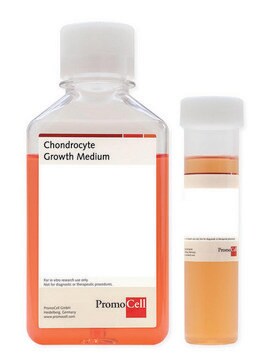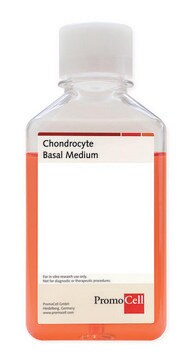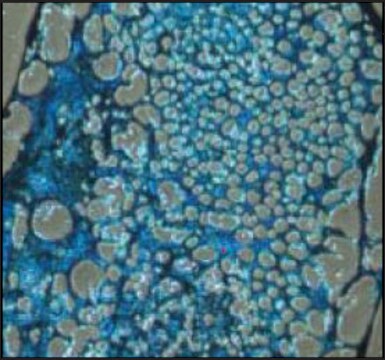402-05A
Human Chondrocytes: HC, adult
Synonyme(s) :
HC cells
About This Item
Produits recommandés
Source biologique
human articular cartilage
Niveau de qualité
Conditionnement
pkg of 500,000 cells
Fabricant/nom de marque
Cell Applications, Inc
Mode de croissance
Adherent
Caryotype
2n = 46
Morphologie
chondrocyte
Technique(s)
cell culture | mammalian: suitable
Maladie(s) pertinente(s)
arthritis
Conditions d'expédition
dry ice
Température de stockage
−196°C
Description générale
Human Chondrocytes, HC, are derived from normal human articular cartilage where they produce and maintain the extracellular matrix of cartilage, including type II collagen. Chondrocytes grown in monolayer culture on a solid surface tend to lose their phenotypic markers and became de-differentiated to a fibroblast-like phenotype. This de-differentiation stage can be reversed by culturing them in a semi-solid gel.
Normal Chondrocytes have been adapted as an in vitro model system in multiple studies looking for cellular mechanisms, such as inflammation-related signaling cascades, abnormal proteinase production, chondrocyte apoptosis and differentiation, as well as novel potential treatments for arthritic disease.
Characterization: Positive for aggrecan after differentiation.
Normal Human Chondrocytes (HC) have been used to:
- Develop a high throughput assay to screen for genes capable of inducing an OA-like phenotype in chondrocytes in order to identify key pathways implicated in the disease (Daouti, 2005)
- Elucidate the signaling cascade leading to induction of proinflammatory cytokines by chondrocytes in RA joints (Aida, 2006; Wang, 2011a,b) and effects of elevated IL-6 signaling on normal chondrocytes (Namba, 2007)
- Investigate mechanisms and identify inhibitors of increased production of proteinases by chondrocytes stimulated by interleukin-1 (Aida, 2005; Wada, 2006), retinoic acid (Hikichi, 2009), proinflammatory cytokines (Tanigawa, 2011a,b), nitric oxide (Wu, 2007; Yang, 2011) and shear stress (Wang, 2011b, 2012)
- Investigate the causes of metalloproteinases induction in patients with Lyme disease-associated arthritis (Lin, 2001; Behera, 2004, 2005)
- Study the factors affecting chondrocyte apoptosis (Cherng, 2008; Malemud, 2012) and differentiation into osteoclasts (Watanabe, 2009a,b; Honda, 2011)
- Show that hyaluronate (HA) can prevent the aggravated cartilage degradation by blocking the matrix metalloproteinases production from cytokine-activated chondrocytes via MKP-1 induction through CD44 signaling (Hashizume, 2009, 2010)
- Demonstrate cytotoxic effects of anti-human Fas/APO-1/CD95 (Fas) monoclonal antibody ARG098 on RA synoviocytes and infiltrating lymphocytes, but not on normal chondrocytes (Tamburstuen, 2010)
Normal Chondrocytes were also utilized in a functional cluster formation agarose assay that allows chondrocytes to maintain their differentiated state (Quintavalla, 2005) and to investigate integrin-mediated mechanotransduction pathways required for proper chondrocyte function (Whitney, 2012). Additionally, they have used extensively in material studies aimed to improve chondrocyte adhesion to medical implants (Gutwein, 2002; Ellison, 2003; Price, 2004; Savaiano, 2004; Burns, 2009) and scaffolds for cartilage regeneration (Jun, 2002; Kay, 2002; Miller, 2002a,b; Price, 2002, 2003; Rao, 2004; Park, 2005; Khang, 2008). Normal chondrocyte RNA was used as a gold standard control in research on cellular reprogramming into chondrocytes (Ishii, 2012).
Origine de la lignée cellulaire
Application
Composants
Notes préparatoires
- 1st passage, >500,000 cells in Basal Medium containing 10% FBS & 10% DMSO
- Can be cultured at least 10 doublings
Procédure de repiquage
Clause de non-responsabilité
Code de la classe de stockage
10 - Combustible liquids
Classe de danger pour l'eau (WGK)
WGK 3
Point d'éclair (°F)
Not applicable
Point d'éclair (°C)
Not applicable
Faites votre choix parmi les versions les plus récentes :
Certificats d'analyse (COA)
Désolés, nous n'avons pas de COA pour ce produit disponible en ligne pour le moment.
Si vous avez besoin d'assistance, veuillez contacter Service Clients
Déjà en possession de ce produit ?
Retrouvez la documentation relative aux produits que vous avez récemment achetés dans la Bibliothèque de documents.
Les clients ont également consulté
Protocoles
Store the cryovials in a liquid nitrogen storage tank immediately upon arrival.
Notre équipe de scientifiques dispose d'une expérience dans tous les secteurs de la recherche, notamment en sciences de la vie, science des matériaux, synthèse chimique, chromatographie, analyse et dans de nombreux autres domaines..
Contacter notre Service technique






